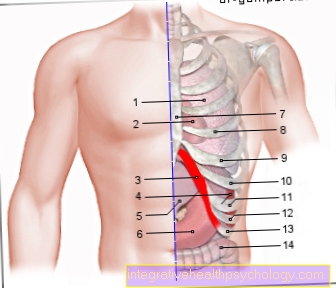Diabetic coma
definition
The diabetic coma is a serious form of metabolic imbalance in patients with diabetes mellitus. The diabetic coma is associated with unconsciousness in around 10% of cases, around 70% of patients are awake, but with reduced consciousness.
The change in the state of consciousness is thus a frequent complication of this diabetic emergency and therefore gives its name to this type of metabolic derailment. The diabetic coma exists in two sub-forms.
On the one hand the ketoacidotic diabetic coma, on the other hand the hyperosmolar diabetic coma. The ketoacidotic coma is more likely to occur in type 1 diabetics, and the hyperosmolar coma is more likely to occur in type 2 diabetics.

Causes of Diabetic Coma
The underlying mechanism differs between the two forms of diabetic coma. What both have in common, however, is that they are triggered by a lack of insulin and favored by infections, because the body's need for insulin changes during infections.
- Ketoacidotic coma: An absolute lack of insulin, the hormone that metabolizes blood sugar, leads to increased blood sugar levels (> 300mg / dl). In addition, the lack of insulin stimulates fat metabolism and breaks down the body's fatty acids. Degradation products are so-called ketone bodies, which lead to acidification (Acidosis) of the blood and give this form of diabetic coma its name. The ketoacidotic coma is very often the first manifestation of type 1 diabetes mellitus in young patients who are for the first time in an absolute deficiency state of insulin.
- Hyperosmolar coma: Here there is a relative lack of insulin. The insulin available to the body is not sufficient to lower the blood sugar level appropriately, which can reach values above 1000 mg / dl. The osmolarity of the blood (number of particles that lead to the flow of fluid into the blood vessels) is increased by the sugar molecules, which is what gives this form of diabetic coma its name. Water flows into the blood vessels (quasi to thin the blood sugar level) and thus leads to dehydration (drying out). The “residual” insulin that is present prevents the metabolism of fatty acids and prevents the formation of ketone bodies and acidification. The most common causes of hyperosmolar coma in type 2 diabetics are treatment with diuretics ("water tablets") and dietary errors.
You might also be interested in: Symptoms of diabetes mellitus, test strips for blood sugar
Diagnosis of diabetic coma
The diagnosis of diabetic coma is suspected by the appearance of the typical signs and symptoms and confirmed by measuring the blood sugar level.
At the ketoacidotic coma if the blood sugar levels are moderately increased (> 300mg / dl), ketone bodies can also be found when examining the urine. Acidification can also be determined by taking a blood sample with an acidic pH value (<7.3).
At the hyperosmolar coma if the blood sugar values are significantly increased (often> 1000mg / dl), there are no ketone bodies in the urine and the pH value of the blood is in the normal range.
You might also be interested in: How do I recognize diabetes?
Signs of diabetic coma
Typical signs of a diabetic coma are the increase in the amount of urine and the frequency of toilet visits, which increase over several days.
As a result, there is a significantly increased amount of water to drink, but the patients are still more likely to be dehydrated, which is shown by dry mucous membranes, dry skin and, in older patients, standing skin folds.
Other signs are rapid fatigue, decreased performance, and nausea and vomiting, which always develop during the course of a diabetic coma.
Concomitant symptoms of diabetic coma
The diabetic coma does not develop suddenly, but over several days. In the course of these days, the diabetic coma can lead to a clouding of the state of consciousness.
Approximately 10% of the patients become completely unconscious, the majority (70%) experience at least a clouded or limited consciousness, which is shown, for example, by increasing confusion. About 20% of the patients do not experience any impairment of consciousness.
The lack of fluids in a diabetic coma can, in addition to the signs mentioned above (increased urine and fluid volume, dehydration), lead to low blood pressure, which in the worst case can lead to a volume deficiency shock with sudden loss of consciousness.
A typical accompanying symptom in ketoacidotic coma is the so-called "Kussmaul breathing", deep breathing that counteracts acidification of the blood by exhaling more CO2 and acetone. These patients often have a fruit-like acetone odor.
In some cases, patients in a ketoacidotic coma experience severe abdominal pain that can resemble appendicitis (Diabetic pseudoperitonitis).
Therapy of diabetic coma
The diabetic coma is a serious emergency. Affected patients must be treated as quickly as possible, as the duration of the diabetic coma has a significant effect on the prognosis and the probability of survival.
Treatment of diabetic coma has four main goals:
- 1. Compensate for the lack of fluids,
- 2. Compensating for electrolyte losses (electrolytes are minerals dissolved in the blood),
- 3. Giving insulin to lower blood sugar levels
- 4. Treatment of hyperacidity in the case of a ketoacidotic coma.
These therapy goals are achieved through the administration of intravenous electrolyte solutions (at the beginning about 1 liter per hour) and normal insulin. The blood sugar level must not be lowered too quickly: a reduction by half in four to eight hours is considered optimal. During the infusion therapy and the administration of insulin, the potassium level in the blood must be monitored and, if necessary, corrected by the administration of potassium.
Patients in a diabetic coma require close monitoring and should be treated in the intensive care unit.
Duration of the diabetic coma
The diabetic coma develops slowly over several days until all symptoms are fully developed.
Both sub-forms begin with a so-called prodromal phase, in which the first symptoms appear: loss of appetite, increasing amounts of drinking and urine, and dehydration of the body due to the loss of fluid. The length of time until a diabetic coma actually occurs is variable and varies from patient to patient. The therapy of blood sugar imbalances and dehydration should be carried out slowly in both subtypes of diabetic coma, for example the loss of fluid should be compensated for over a period of up to 48 hours. A general statement about the length of time a patient will be in a diabetic coma and how long the therapy will last cannot be made, but must be discussed with the treating physician on a case-by-case basis.
Consequences of the diabetic coma
The severe lack of fluids can lead to low blood pressure and a volume deficiency shock.
This volume deficiency shock can impair kidney function: the amount of urine decreases significantly or urine production stops entirely as a result of acute kidney failure.
Electrolyte disturbances are to be expected due to the shifts in the body's water balance. For example, if the potassium level is not in the correct range, cardiac arrhythmias are the result. The ketoacidotic coma, which is more likely to occur in young patients, can be accompanied by abdominal pain (Diabetic pseudoperitionitis, see above) is often confused with appendicitis. The result is an operation on the appendix, which actually would not have been necessary and has all the typical complications of an operation (scarring, infection, etc.).
The treatment of the diabetic coma can also cause consequential damage: If the blood sugar level is lowered too quickly by infusions during the treatment of the diabetic coma (i.e. it is diluted by too much intravenous fluid), there is a risk of cerebral edema. The excess fluid is deposited in the brain substance, which leads to headaches, dizziness, nausea and vomiting. Visual and consciousness disorders are also possible. In the worst case, cerebral edema can lead to entrapment of the brain stem and cause brain death. About a third of patients with cerebral edema suffer permanent neurological damage.
Survival probability of diabetic coma
The death rate from diabetic coma is high. In the case of a ketoacidotic coma, it is between one and ten percent, so the probability of survival is over 90 percent.
In hyperosmolar coma, the mortality rate is 40 to 60 percent, significantly higher, as these patients are mostly older and therefore have a poorer prognosis.
The prognosis of a diabetic coma also depends on how long the patient was in this condition and how badly the metabolism was derailed.





























